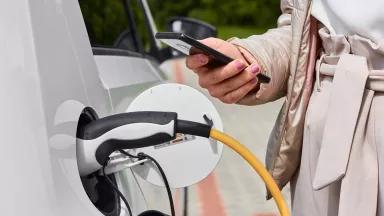Is Now a Good Time to Buy an Electric Car?
Electric vehicles offer plenty of benefits. Here’s how to decide if you’re ready for yours.

Egle Plytnikaite
Thinking of buying an electric vehicle? You’re not alone. EV sales surged last year to 9 percent of car sales worldwide, up from 2.5 percent in just 2019. Manufacturers are also adding nearly 80 new passenger EV models to the U.S. market in the coming years, and the federal government is investing billions to help build out a more robust network of charging stations. That’s great news because the United States is the world’s second-largest producer of greenhouse gases, and transportation accounts for the largest share of carbon pollution of any sector of the U.S. economy. By ditching gasoline, EV drivers reduce those emissions, improve local air quality, and spare themselves hundreds of dollars each year in fueling costs.
But the move can be intimidating. Here's what you'll want to take into account before you pull the trigger on your first electric car.
Factor the initial and long-term costs of EV ownership into your budget.
- Sticker price: While the average cost of a new electric vehicle is around $56,000, EVs still offer a lower total cost of ownership than their gas-powered counterparts. Plus, upfront costs are dropping. There are already multiple EV models under $40,000, the Nissan Leaf being the cheapest. And a few resources can help further lower the sticker price. Start by seeing if you qualify for the federal EV tax credit, which is worth up to $7,500 for new EVs and $4,000 for used EVs. (One note: New manufacturing requirements impact which new vehicles qualify for this credit. Learn more in our consumer guide to the Inflation Reduction Act.) You can also check to see if your state offers additional incentives.
- Initial setup: Most EVs come with what’s called a “Level 1” charger, which can plug into your traditional 120-volt outlet (the same kind you’d plug in, say, a lamp or your phone). But many EV drivers also install what’s known as a “Level 2,” 240-volt outlet into their garage for faster charging. The cable and installation will run you a couple of grand, but there are programs that can help reduce or eliminate this cost.
- Fuel: EVs let you skip out on (increasingly) expensive trips to the pump. In fact, charging an electric vehicle at home is roughly the equivalent of fueling up on a dollar-a-gallon gasoline. And one study suggests the average EV driver saves between $800 and $1,000 per year on fuel costs. But regional electricity costs, the efficiency of your EV model, and where you charge all impact this number. To get a rough estimate of your monthly charging costs, multiply your car’s kilowatt-hour (kWh)/100 miles rate (the EV equivalent of miles per gallon) by your electricity rate, which you can find on your utility bill. This will give you the electricity cost per 100 miles driven. Keep in mind that at public charging stations, you’ll tend to pay more—about $10 to $45 to fully charge your car—compared to when you plug in at home.
- Maintenance: These costs tend to run about 31 percent less for electric vehicles than their gas-powered counterparts because you get to bypass things like oil changes or spark plug replacement. So factor in those savings.
Assess your typical driving needs.
“Range anxiety” tends to be a big concern for new EV drivers. So it’s worth noting that, depending on the car model, EVs can go anywhere from 100 to 520 miles on a single charge—many times farther than the 31.5 miles that the average U.S. car owner drives each day. Even the affordable Chevy Bolt can run for nearly 250 miles on a full charge, and certain luxury EVs nearly double that. You can also consider a plug-in hybrid vehicle, which operates primarily on electricity but can switch to gasoline for longer trips and eliminate range anxiety entirely.
To figure out your needs, start by taking stock of your regular car use. How far is your daily commute? How often do you take longer-mileage trips, like visiting family or traveling for work? Even if you occasionally take trips outside of your electric vehicle’s range, you can plan to use public charging stations and be just fine.
Consider how you will regularly charge your electric vehicle.
More than 80 percent of EV charging happens at home—typically in the garage. You can plug your electric car into the normal 120-volt outlet, but this can take up to 40 hours to fully charge your battery. Level 2 charging, by comparison, allows you to conveniently go from zero to full battery in about six hours, or overnight. It’s also worth noting that plug-in hybrids can be fully recharged overnight with just the standard 120-volt outlet.
Do you live in an apartment complex? If so, you may be able to petition your building manager to get EV charging stations installed—some states offer incentives that cover the full infrastructure and installation costs. (Here’s a template letter to get you started.) If that’s not feasible, you’ll have to rely on public charging stations. This can be slightly less convenient but still doable. The good news is that public charging stations are becoming more ubiquitous. Some charging stations even offer Level 3, DC fast charging (DCFC)—which is faster, higher-voltage charging at a slightly higher rate. Sites like PlugShare and ChargeHub allow you to take stock of the current charging stations near you, which will grow by the thousands in the coming years as the inevitable electric vehicle revolution speeds up.
This NRDC.org story is available for online republication by news media outlets or nonprofits under these conditions: The writer(s) must be credited with a byline; you must note prominently that the story was originally published by NRDC.org and link to the original; the story cannot be edited (beyond simple things such as grammar); you can’t resell the story in any form or grant republishing rights to other outlets; you can’t republish our material wholesale or automatically—you need to select stories individually; you can’t republish the photos or graphics on our site without specific permission; you should drop us a note to let us know when you’ve used one of our stories.




As Demand Grows for Electric Cars, So Does the Market for Green Jobs in the EV Industry
A Consumer Guide to the Inflation Reduction Act
Electric vs. Gas Cars: Is It Cheaper to Drive an EV?
As Demand Grows for Electric Cars, So Does the Market for Green Jobs in the EV Industry
A Consumer Guide to the Inflation Reduction Act
Electric vs. Gas Cars: Is It Cheaper to Drive an EV?
As Demand Grows for Electric Cars, So Does the Market for Green Jobs in the EV Industry
A Consumer Guide to the Inflation Reduction Act
Electric vs. Gas Cars: Is It Cheaper to Drive an EV?
As Demand Grows for Electric Cars, So Does the Market for Green Jobs in the EV Industry
A Consumer Guide to the Inflation Reduction Act